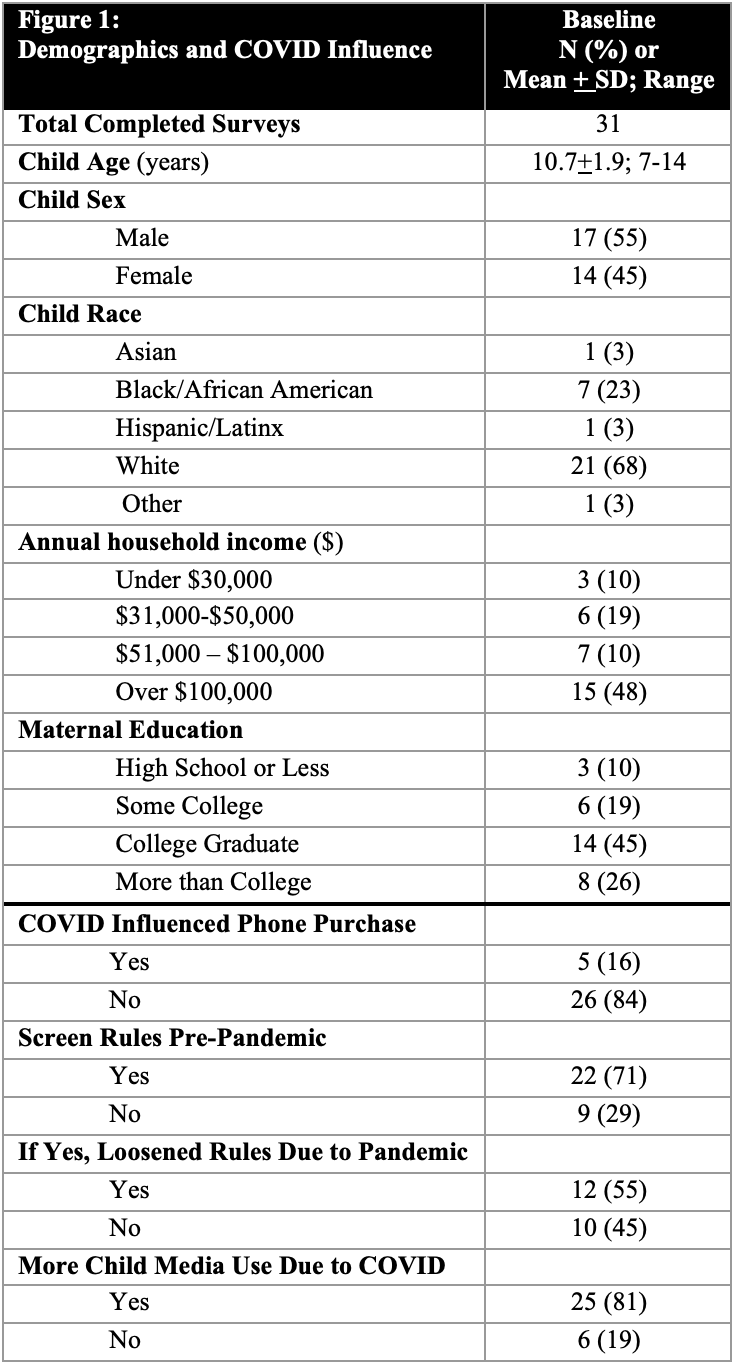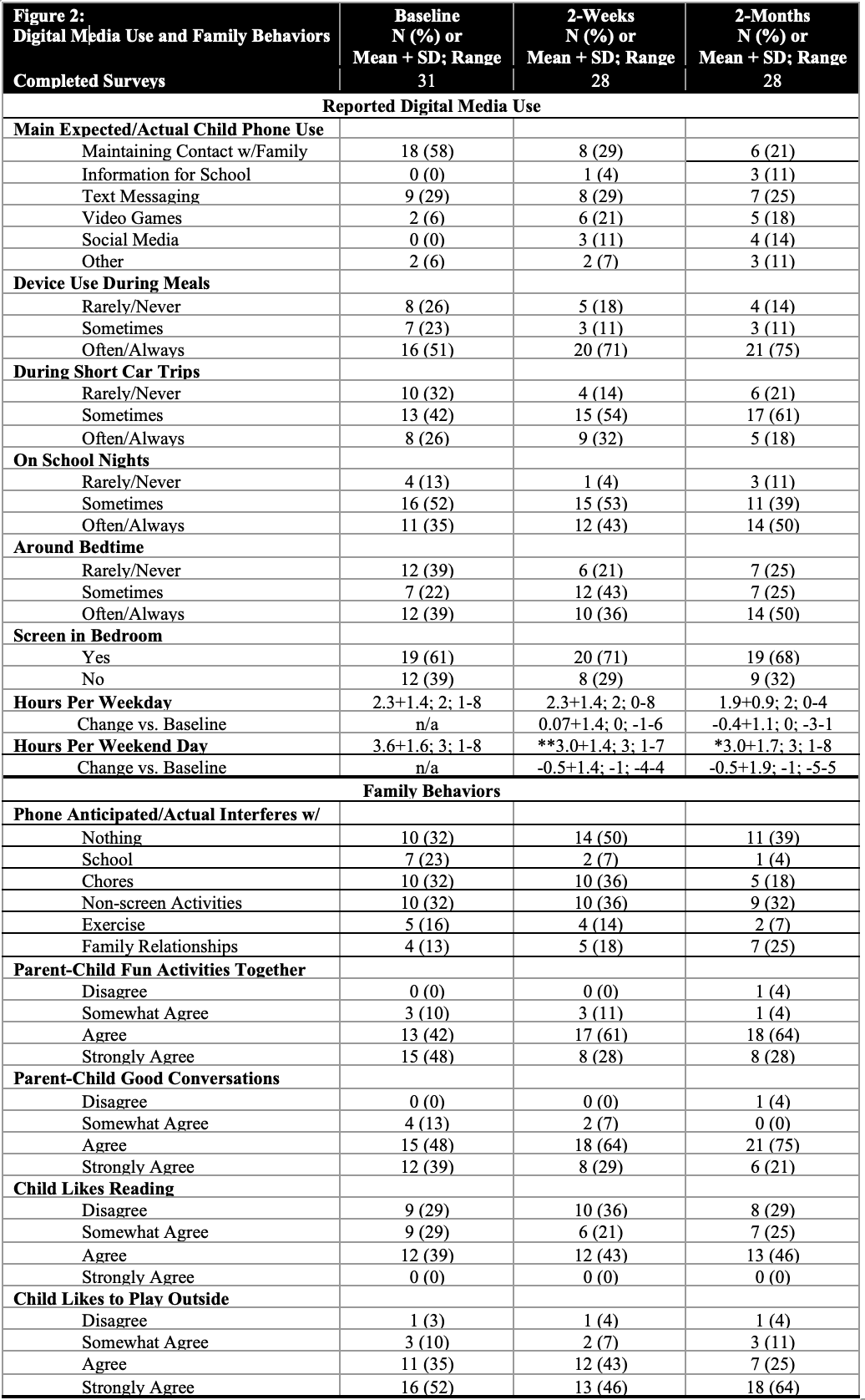General Pediatrics: Primary Care/Prevention
Category: Abstract Submission
General Pediatrics VI
112 - Impact of First Smartphone Purchase on Child Digital Media Use and Family Behaviors
Monday, April 25, 2022
3:30 PM - 6:00 PM US MT
Poster Number: 112
Publication Number: 112.410
Publication Number: 112.410
John S. Hutton, Cincinnati Children's Hospital Medical Center, Cincinnati, OH, United States; Guixia Huang, Cincinnati Children's Hospital Medical Center, Cincinnati, OH, United States; Clare Crosh, Cincinnati Children's Hospital Medical Center, Cincinnati, OH, United States

John Hutton, MD MS
Assistant Professor
Cincinnati Children's Hospital Medical Center
Cincinnati, Ohio, United States
Presenting Author(s)
Background: The American Academy of Pediatrics (AAP) recommends limiting digital media use (“screen time”), citing cognitive, behavioral, family relational and health risks. Recent surveys estimate that 12% of US children have a smartphone by age 8 and a majority by age 12, though this is younger than recommended. Reported family media use has accelerated during the COVID pandemic, including to remain connected to friends, family and school.
Objective: To explore relationships between a first smartphone purchase and subsequent digital media use and family dynamics.
Design/Methods: Families were recruited from late 2020 through mid-2021 by social media and email ads. Eligibility criteria were plan to purchase first phone within 3 months, child age under 18 years and English-speaking family. Phone surveys were administered to a parent by a research coordinator pre-purchase (baseline) and then repeated 2-weeks and 2-months later. These included demographics, digital media use (contexts, amount, limits), family activities and how COVID impacted the decision to purchase, rules and use. Analyses involved descriptive statistics, non-parametric tests of repeated measures and correlations between primary outcomes and child age, sex and income level.
Results: A total of 31 parent-child dyads (29 mothers) were enrolled and 28 completed both follow-up surveys, with child age from 7 to 14 years old (demographics, Figure 1). A minority (16%) reported COVID as influencing the decision to purchase their child a phone, though most reported relaxing rules and higher media use (Figure 1). Anticipated and actual phone use shifted from maintaining contact with family to other activities. Changes in media use (contexts, amount) and family behaviors are summarized in Figure 2. Reported use decreased overall though changes were highly variable, with weekday use positively correlated with age (Spearman, p< 0.05) and male sex (p < 0.10; Figure 3). Interference with family relationships was the most often cited concern, with trends towards less fun activities and conversations and no change in reading or outdoor play (Figure 2).Conclusion(s): In this study involving parents and 7- to 14-year-old children, there were small but intriguing relationships between first smartphone purchase, subsequent digital media use and family activities. Overall yet highly variable decrease in hours/day may reflect differential susceptibility to overuse and/or greater difficulty monitoring phone use relative to other formats. Further studies are needed to characterize longer-term impacts, accounting for child temperament and family circumstances.
Figure 1: Demographics and Influence of COVID Descriptive statistics related to sample demographics and influence of COVID on child smartphone purchase and child digital media use.
Descriptive statistics related to sample demographics and influence of COVID on child smartphone purchase and child digital media use.
Figure 2: Child Digital Media Use and Family Behaviors Descriptive statistics regarding anticipated/actual smartphone use, overall child digital media use and family behaviors before and ofter child smartphone purchase.
Descriptive statistics regarding anticipated/actual smartphone use, overall child digital media use and family behaviors before and ofter child smartphone purchase.
Objective: To explore relationships between a first smartphone purchase and subsequent digital media use and family dynamics.
Design/Methods: Families were recruited from late 2020 through mid-2021 by social media and email ads. Eligibility criteria were plan to purchase first phone within 3 months, child age under 18 years and English-speaking family. Phone surveys were administered to a parent by a research coordinator pre-purchase (baseline) and then repeated 2-weeks and 2-months later. These included demographics, digital media use (contexts, amount, limits), family activities and how COVID impacted the decision to purchase, rules and use. Analyses involved descriptive statistics, non-parametric tests of repeated measures and correlations between primary outcomes and child age, sex and income level.
Results: A total of 31 parent-child dyads (29 mothers) were enrolled and 28 completed both follow-up surveys, with child age from 7 to 14 years old (demographics, Figure 1). A minority (16%) reported COVID as influencing the decision to purchase their child a phone, though most reported relaxing rules and higher media use (Figure 1). Anticipated and actual phone use shifted from maintaining contact with family to other activities. Changes in media use (contexts, amount) and family behaviors are summarized in Figure 2. Reported use decreased overall though changes were highly variable, with weekday use positively correlated with age (Spearman, p< 0.05) and male sex (p < 0.10; Figure 3). Interference with family relationships was the most often cited concern, with trends towards less fun activities and conversations and no change in reading or outdoor play (Figure 2).Conclusion(s): In this study involving parents and 7- to 14-year-old children, there were small but intriguing relationships between first smartphone purchase, subsequent digital media use and family activities. Overall yet highly variable decrease in hours/day may reflect differential susceptibility to overuse and/or greater difficulty monitoring phone use relative to other formats. Further studies are needed to characterize longer-term impacts, accounting for child temperament and family circumstances.
Figure 1: Demographics and Influence of COVID
 Descriptive statistics related to sample demographics and influence of COVID on child smartphone purchase and child digital media use.
Descriptive statistics related to sample demographics and influence of COVID on child smartphone purchase and child digital media use.Figure 2: Child Digital Media Use and Family Behaviors
 Descriptive statistics regarding anticipated/actual smartphone use, overall child digital media use and family behaviors before and ofter child smartphone purchase.
Descriptive statistics regarding anticipated/actual smartphone use, overall child digital media use and family behaviors before and ofter child smartphone purchase.